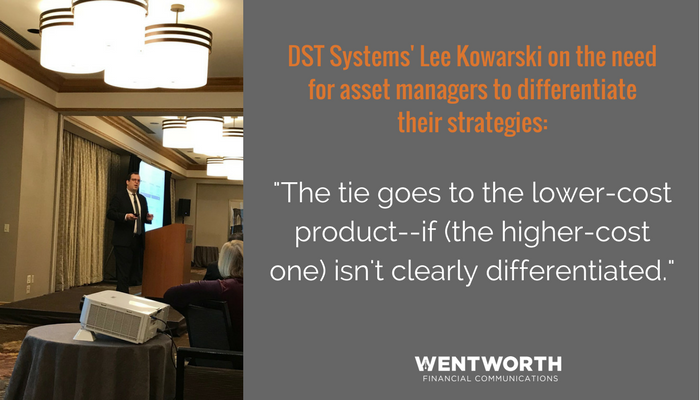The disruptive forces that are reshaping the asset management industry—robo advisors, fee compression, consolidation, regulatory change, just to name a few—are well known. What’s not as clear, however, is how asset managers need to adapt their marketing communications to succeed in this new landscape.
According to Lee Kowarski, a keynote speaker at PAICR’s 2017 annual conference in New York City, navigating these disruptive forces is a matter of survival for asset managers, and marketing’s ability to articulate a firm’s differentiation is more important than ever.

“As scary as (the current era of rapid change) can be, we look at it as a pretty exciting time,” said Kowarski, a vice president at DST Systems, which provides advisory, technology, and operations outsourcing to the financial and healthcare industries. “It’s a time when you actually can separate yourself from the pack and a time when marketing is going to be very much elevated in organizations. … (Marketing) is really going to be a differentiator for organizations.”
In his speech to the investment marketing and communications professionals who gathered in November for PAICR’s annual conference, Kowarski said that communicating effectively in the age of disruption requires marketers to ask tough questions about their firms. Questions like:
- “What do you have that actually resonates with the marketplace and how do you tell that story?” These are the central questions that marketers must answer when articulating their firm’s points of differentiation. Kowarski pointed to Volvo (safety) and BMW (performance and luxury) as examples of brands that have been very effective in defining, in consumers’ minds, what those brands are uniquely qualified to deliver—something that asset managers’ marketing teams are notoriously bad at. Kowarski said that asset management marketers would be wise to spend more time talking with the firm’s sales team and learning what themes and examples resonate with investors. “What I typically find is that your salespeople are telling stories about what makes your firm unique, but those stories aren’t coming across in your marketing efforts.”
- “Where do we fall on the spectrum?” Kowarski predicted that there will be a bifurcation in terms of the most successful asset managers over the next decade. At the large end of the spectrum, the mega managers will succeed by being able to decrease fees and rationalize necessary investments in technology, data analytics, distribution, and marketing across enormous asset bases. Meanwhile, niche firms that have done an effective job of articulating what makes them unique and narrowed their product lineups accordingly, will attract investors who are looking for specialist managers.
Unfortunately, many firms today are stuck in the middle, Kowarski said. And in the face of ongoing consolidation, this middle ground is becoming increasingly untenable. “Consolidation is forcing companies to think: How are we running our business? Are we set up for the long term? How are we differentiated? Why should someone do business with our organization as opposed to someone who does nothing except that specific type of investing or someone who has the scale to support (the necessary spending) from a sales and marketing standpoint?” - “How do you leverage technology to produce content while still thinking about what’s unique about your firm?” Just as financial advisors are increasingly using robo platforms to handle portfolio management decisions, freeing them up to spend more time with their clients, asset management marketers need to think about how they can use technology to automate aspects of their content creation and distribution efforts. Kowarski said that opportunities to achieve technology-enabled scale are particularly large with recurring marketing collateral, such as quarterly market commentaries or monthly portfolio reports. The more that elements of creating and distributing this collateral can be automated, the more time marketers have to focus on telling the firm’s story in a compelling way.
- “As performance dispersion decreases, what’s justifying your fees?” Kowarski shared research showing that since 2001, average return dispersion among actively managed funds has decreased by about 50%. Meanwhile, investors have been flocking to passively managed, low-cost funds, driving average asset-weighted fees down 30% during that span. “The tie goes to the lower-cost product—if (the higher-cost one) isn’t clearly differentiated,” Kowarski said. He said that by articulating their firms’ unique areas of expertise, marketers play a vital role in creating pricing power for their investment strategies. “If you’re not going to be in the race to zero (in terms of fees), how do you justify the fees you are charging? How do you tell that story?”
- “How do we bring (white papers) to life through infographics, videos, and other elements?” When describing the flawed mindset that plagues many asset managers’ approach to marketing, Kowarski said that it isn’t uncommon for the product teams to develop white papers on their own and then go to the marketing team and say, “Here’s our latest white paper. Put it on the website.” Kowarski said that marketing needs to be involved in every step of the process and be focused on finding ways to use high-engagement tools to promote the most interesting elements of the paper. This can be a powerful way to engage your target audience and ensure that your white papers and other content are fully supporting the firm’s sales and marketing strategy. To learn more about ways to promote the insights from your white papers, see our post “What Trees Falling in Forests Have to Do With White Papers.”
The need for asset managers to adopt a new mindset in response to disruptive forces certainly isn’t limited to marketing, Kowarski said. It also applies to rethinking distribution models, rationalizing product lineups, and harnessing machine learning and data analytics across the organization. “The firms that really invest in these areas … are going to be the ones that survive,” Kowarski said. “You need to start experimenting today.”
About the Author
 Scott Wentworth is the founder and head financial writer at Wentworth Financial Communications. Scott and the team of writers and editors at WFC help professionals across the financial services industry build their brands by creating investment-grade white papers, bylined articles, newsletters, blogs, social media posts, and other forms of content marketing.
Scott Wentworth is the founder and head financial writer at Wentworth Financial Communications. Scott and the team of writers and editors at WFC help professionals across the financial services industry build their brands by creating investment-grade white papers, bylined articles, newsletters, blogs, social media posts, and other forms of content marketing.
